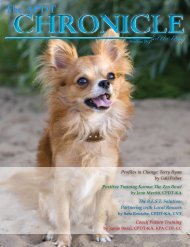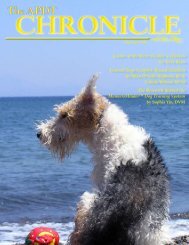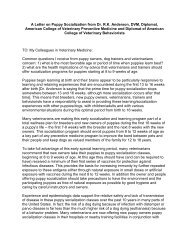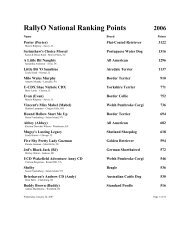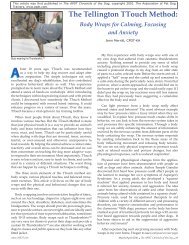of the Dog - Association of Pet Dog Trainers
of the Dog - Association of Pet Dog Trainers
of the Dog - Association of Pet Dog Trainers
Create successful ePaper yourself
Turn your PDF publications into a flip-book with our unique Google optimized e-Paper software.
Endotes<br />
1. Miklósi, Á., Topál, J., Virányi, Z., “Comparative social<br />
cognition: what can dogs teach us?,” Animal Behavior 67<br />
(2004): 995-1004.<br />
2. Hare, Brian and Tomasello, Michael, “Human-like social<br />
skills in dogs?,” Trends Cognitive Science 9.9 (September<br />
2005): 439-444.<br />
3. Miklósi, Á., Topál, J., Virányi, Z., op, cit.<br />
4. Csányi, Vilmos, If <strong>Dog</strong>s Could Talk (New York: North<br />
Point Press, 2000)<br />
5. Woodard, Colin, “Clever Canines: Did Domestication<br />
Make <strong>Dog</strong>s Smarter?” The Chronicle <strong>of</strong> Higher Education<br />
Research, (April 15, 2005): A12.<br />
6. Miklósi, Á, The Chronicle <strong>of</strong> Higher Education, on-line chat,<br />
April 14, 2005, 2 p.m. EDT, Rich Monastersky, moderator.<br />
(http://chronicle.com/colloquy/2005/04/dogs/); and<br />
Soproni, K. and Miklósi, Á,, “Comprehension <strong>of</strong> Human<br />
Communicative Signs in <strong>Pet</strong> <strong>Dog</strong>s (Canis familiaris),<br />
Journal <strong>of</strong> Comparative Psychology 115:2 (2001) 122-126.<br />
7. Soproni, K. and Miklósi, Á, ibid.<br />
8. Pongrácz, Péter, Molnár, Csaba, Miklósi, Ádám,<br />
“Acoustic parameters <strong>of</strong> dog barks carry emotional<br />
information for humans,” Applied Animal Behaviour Science<br />
100.3-4 (2006): 228-240; and Miklósi, Á, Polgárdi, R., Topál,<br />
J., Csányi, V, “Intentional behaviour in dog-human<br />
communication: an experimental analysis <strong>of</strong> “showing”<br />
behaviour in <strong>the</strong> dog,” Animal Cognition 3 (2000): 159-166.<br />
9. Survey Monkey http://www.surveymonkey.com/ (<br />
http://www.surveymonkey.com/s.aspx?sm=HkCWgzYo_2bN5P<br />
4n_2blq1SlMQ_3d_3d).<br />
10. The essay question on behavior read, “Please describe<br />
in detail <strong>the</strong> intentional original behavior your dog created to<br />
communicate a specific message to you. This should NOT be a<br />
behavior that you or someone else taught your dog to do.”<br />
11. The essay question about messages read, ““What message<br />
do you think your dog wants to communicate to you by this<br />
special behavior? Does your dog display this behavior at any<br />
o<strong>the</strong>r time?”<br />
12. Equation for baseline calculations: (#individual response/<br />
total responses x 100 = mean % baseline).<br />
13. Variables: AKC group, age, gender, o<strong>the</strong>r pets, how acquired,<br />
owner and trainer, class attendance, activities.<br />
14. Bek<strong>of</strong>f, Marc, Animal Passions and Beastly Virtues:<br />
Reflections on Redecorating Nature (Philadelphia: Temple<br />
University Press, 2006) 24-27.<br />
15. Pongrácz, Péter, Miklósi Ádám, Csányi, Vilmos,<br />
“Owner’s beliefs on <strong>the</strong> ability <strong>of</strong> <strong>the</strong>ir pet dogs to<br />
understand human verbal communication: A case <strong>of</strong> social<br />
www.APDT.com<br />
understanding.” Current Psychology <strong>of</strong> Cognition (2001) 20<br />
(1-2) 87-107.<br />
16. Pongrácz, ibid.<br />
17. Miklósi, Ádám, Kubinyi, Enikö, Topál, József,Gácsi,<br />
Márta , Virányi, Zsófia & Csányi, Vilmos, “A Simple Reason<br />
for a Big Difference: Wolves Do Not Look Back at Humans,<br />
but <strong>Dog</strong>s do,” Current Biology 13 (April 29, 2003): 763-766.<br />
18. Multiple choice options were used for acquisition<br />
responses. However, respondents may not have accurately<br />
cited from where <strong>the</strong>y acquired <strong>the</strong>ir dogs. For example,<br />
some may have considered a “pr<strong>of</strong>essional breeder” to be<br />
one who sells pets in a parking lot.<br />
19. Baseline: avoidance (5%), permission (3%), play (6%). <strong>Dog</strong>s<br />
with non-candid pets: avoidance, permission, play 13% each.<br />
20. Soproni, op. cit.<br />
21. Bek<strong>of</strong>f, op. cit.<br />
22. Survey Respondent 1-56.<br />
23. Survey respondent #1-17.<br />
24. Virányi, Zsófia, Topál, József, Gácsi, Márta, Miklósi,<br />
Ádám, Csányi, Vilmos, “<strong>Dog</strong>s respond appropriately to<br />
cues <strong>of</strong> humans’ attentional focus,” Behavioral Processes<br />
66 (2004): 161-172. and Miklósi, Á., Topál, J., Virányi, Z.,<br />
“Comparative social cognition: what can dogs teach us?,”<br />
Animal Behavior 67 (2004): 995-1004.<br />
25. Pongrácz, Péter, Miklósi Ádám, Kubinyi, Enikö,Topál,<br />
József, Csányi, Vilmos, “Interaction between individual<br />
experience and social learning in dogs,” Animal Behaviour<br />
65 (2003): 595-603; and Pongrácz, Péter, Miklósi, Ádám,<br />
Timár-Geng and Csányi, Vilmos, “Vocal Attention Getting<br />
as a Key Factor in Social Learning Between <strong>Dog</strong> (Canis<br />
familiaris) and Human”, Journal <strong>of</strong> Comparative Psychology<br />
118:4 (2004): 375-383; and Kubinyi, Enikö, Miklósi Ádám,<br />
Topál, József, Csányi, Vilmos “<strong>Dog</strong>s (Canis familiaris) Learn<br />
From Their Owners via Observation in a Manipulation<br />
Task”, Journal <strong>of</strong> Comparative Psychology 117:2 (2003): 156-<br />
165.<br />
26. Pongrácz, Ibid; and Kubinyi , Ibid; and Range,<br />
Friederike, Viranyi, Zsófia, Huber, Ludwig, “Selective<br />
Imitation in Domestic <strong>Dog</strong>s”, Current Biology 17 (May 15,<br />
2007).<br />
27. Miklósi, on-line chat, op.cit.<br />
November/December 2008 w The APDT Chronicle <strong>of</strong> <strong>the</strong> <strong>Dog</strong> w 31<br />
Creative Canine: Original Intentional Canine-to-Human Communication





